Dark Paradise: A Conversation With Shara Hughes

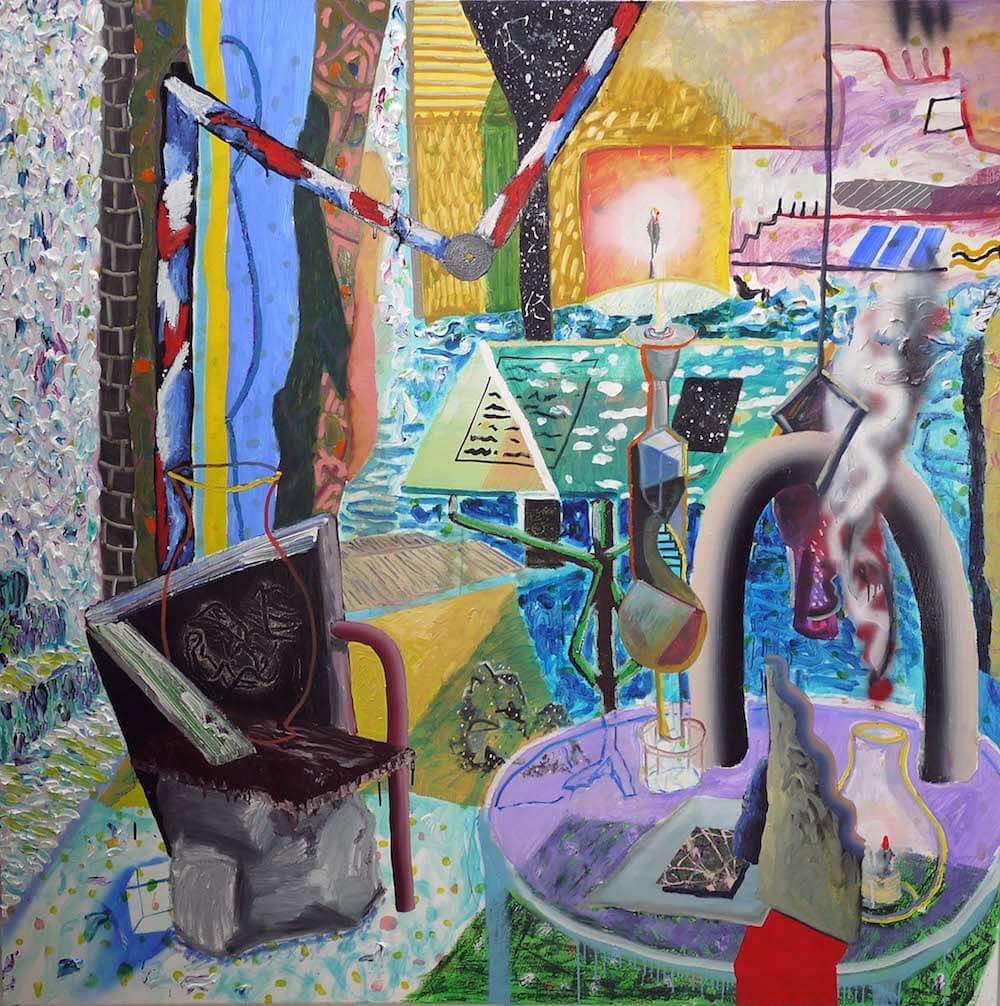
“I’m really connected with the act of painting,” explains Brooklyn-based artist Shara Hughes as she tries to corral her Boston Terrier Chicken Nugget in her Greenpoint studio. She almost didn’t need to say it. Looking around Hughes’s studio, it’s hard to miss her enthusiasm for painting. A wide array of paints, dyes and other art supplies fill an enormous central table, while brightly colored canvases in various stages of completion are scattered around the space, including several created for an upcoming show at the Newport Art Museum.
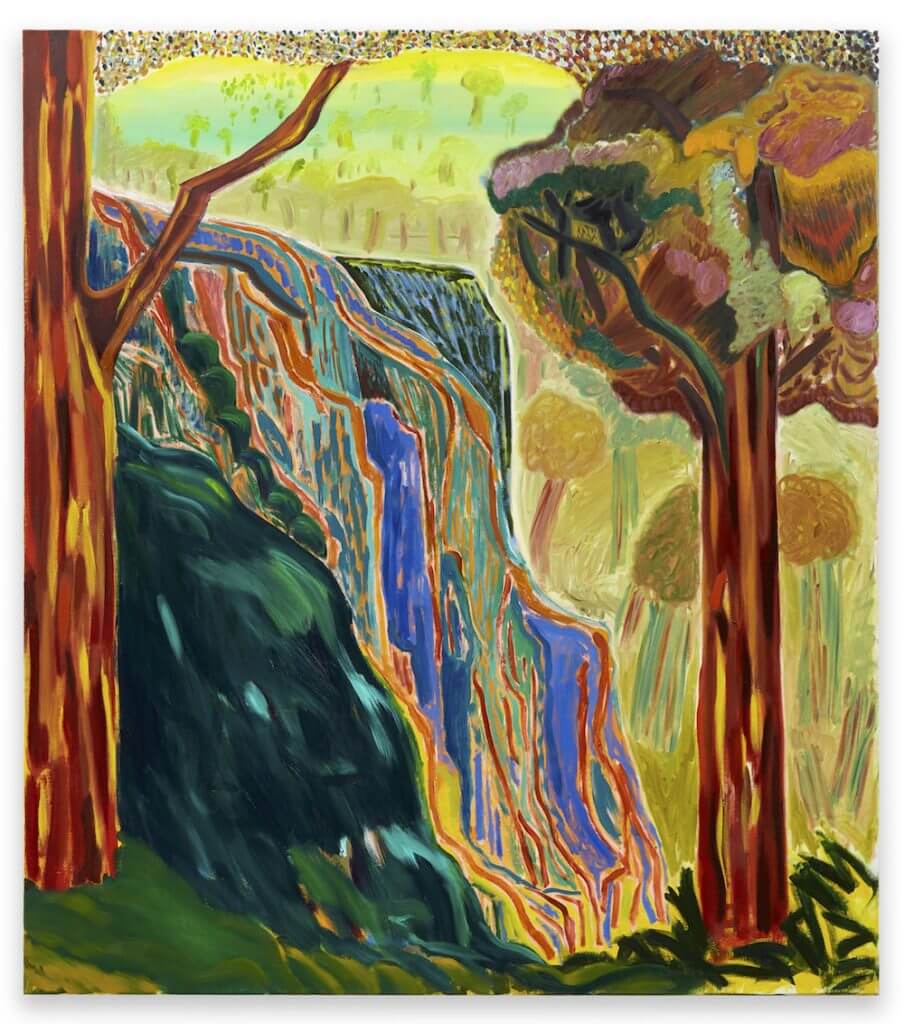
The sheer amount of art and materials isn’t the only evidence of her engagement with painting. Her adoration of the practice is also equally visible in the work itself with her vibrant colors, swooping lines and unexpected forms that dominate her recent landscapes. On one wall, a canvas depicts looming trees that seem to slide into a river dotted with red, yellow and blue splotches, while another features long winding lines in brilliant, almost fluorescent tones. At once alluring and ominous, Hughes’s landscapes are derived from her imagination rather than nature itself. This allows for a sense of both familiarity and surrealism, as well as makes it easy for the viewer to lose themselves within these dreamlike environments.
Stopping by Hughes’s studio the day before she left for the opening of her show Sticks and Stones at Berggruen Gallery in San Francisco, we spoke about her transition to landscape painting, her recent foray into printmaking and how depicting an invented world can be a reaction to our current age of anxiety.
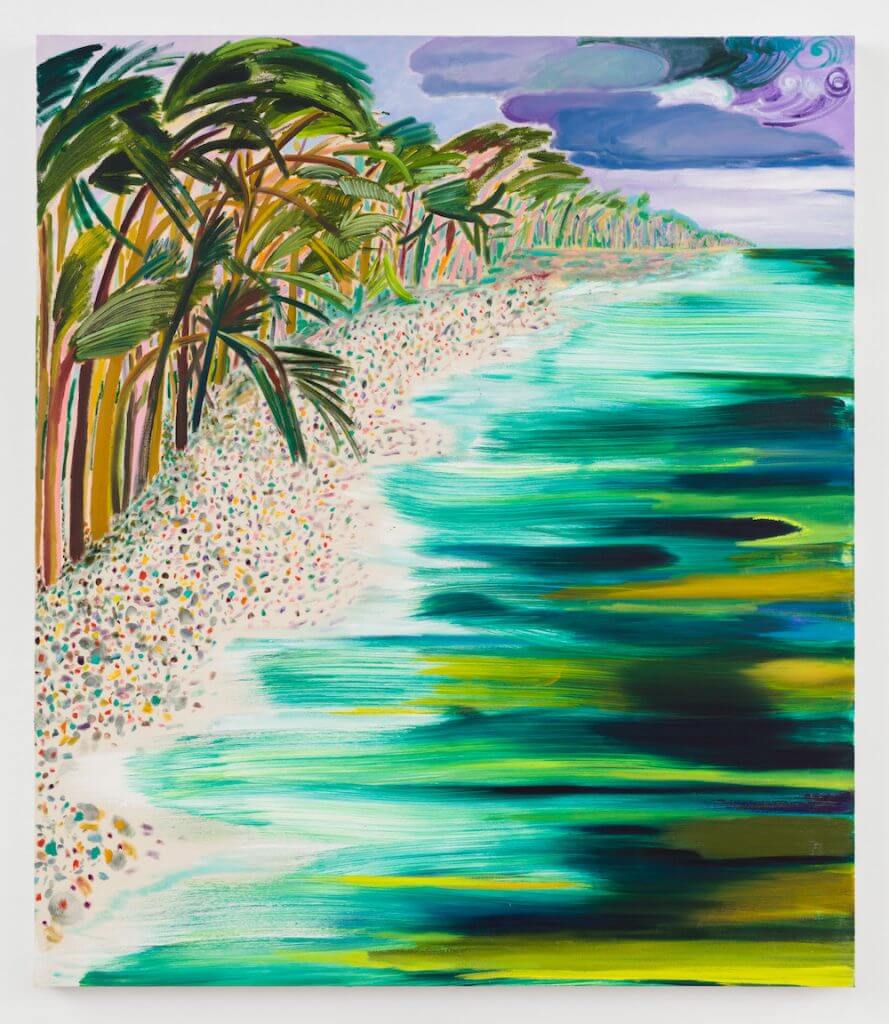
What inspired you to start making landscape paintings?
Right when I moved to New York four years ago, I felt a sense of urgency to have to control everything. I had lived here before, but even knowing what to expect, I felt out of control. It’s overwhelming. In my studio, the work I was making when I moved here was getting really strangled. I was tired of having to have a story or a reason to make a painting. I wasn’t having any shows coming up and there wasn’t any action going on so I thought, “Whatever, I’m going to make something that doesn’t really matter to me or anyone. I just want to trust myself and make a painting. I’m going to make some dumb landscapes.” And all of a sudden, I was like, “Wait a second! These are kind of good.” I felt more freedom and it really opened things up. I trusted I could make a good painting rather than having to prove it to myself or anyone else with symbolism or a reason for doing anything. It’s funny how I fell into it. I thought I’m going to make the most boring thing ever and they became the most amazing things for me personally to make. Now, all I care about is landscape.
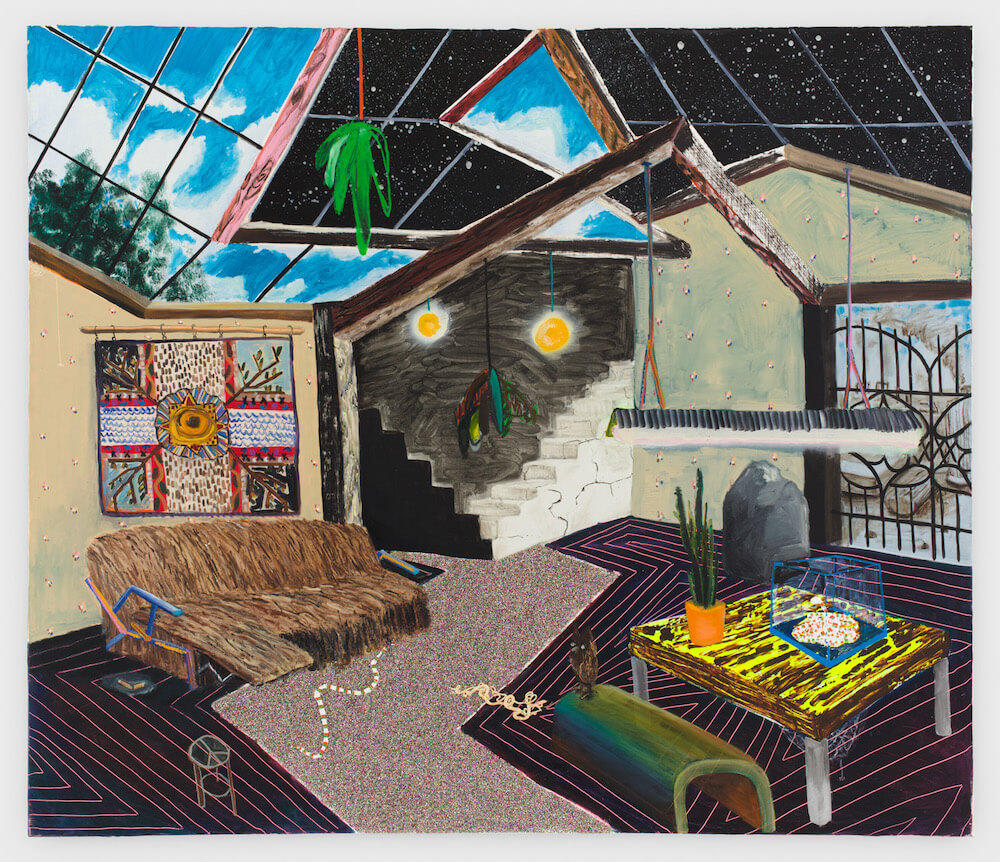
I looked at some of your earlier work that’s currently in The Lure of the Dark at MASS MOCA such as Like Night and Day, which, as an interior, is strikingly different from your more recent landscapes. How do you see the progression of your work in the past several years?
I was making interiors for a long time. When I was making those paintings, there was a tragedy in my family that I was dealing with so everything in the paintings became a symbol of protection, armor, escape or a pair of threes that symbolized my brothers and me. Then, when I got over those situations, I realized I only knew how to paint when I had a reason or something I was going through to give me motivation. I thought that was how you were supposed to be an artist. But, that doesn’t really make sense. You’re not going to always be struggling with something. I struggled for a few years trying to figure out what it meant to make a painting about being ambivalent, happy or unsure. Or what it meant to just make a painting because you wanted to make paintings. I finally understood that when I moved here. It was interesting the way it moved on from interiors into a brief period of figure paintings and then, to landscapes. And now, I feel like it’s just opened everything up.
Looking around at all the materials you use, I’m wondering about your studio practice. Is experimentation a huge part of your process?
It is. There’s never really a plan, which is nice because I never have to have that anticipation or anxiety of how to start and what it’s going to be. I have this trust in myself that it’ll happen. The earlier work usually came out of a certain title or something that was connected to what I was going through. They weren’t even necessarily planned either, but they might have a sort of idea before I would start. For example, Like Night And Day is about when you think you know somebody, but they change into a completely opposite person. I knew I wanted to make an interior that had the feeling of both night and day. There’s still looseness to it, but there was some sort of structure whereas now there’s just nothing.

I’m glad you brought up your titles. With titles like No Touch of Gray and Pains and Needles, your titles are very poetic and not the basic “Untitled” that so many artists use. What is the role of your titles?
I’ve always really liked titles. I think of them as almost another brushstroke or a suggestion of what you’re looking at. It’s another sort of clue. I never want to close the door on what any of them are about. A lot of people don’t read titles or care. I like the painting to be enough with or without it, but I personally like the title to be like an extra punctuation mark.

When I look at your vibrant colors, I immediately think of David Hockney’s paintings. Who are your artistic inspirations?
David Hockney is amazing. I was so into him when I was making interior paintings. He can’t do anything wrong in my book. I have to not look at him too much actually. If I happen to think of one of his works, I start to think, “Oh God, did I make the exact painting, but worse?” I’m looking at artists who may be really unexpected like Helen Frankenthaler and Elizabeth Murray. I also look at Renaissance painting just for compositions and the simplicity of a certain type of day. I try to look at things that aren’t going to be that obvious, but no matter what people are going to ask, “Do you look at Burchfield?” or “Have you ever heard of Milton Avery?” That’s always going to happen so I embrace it. Of course, I’m influenced by these people. It’s impossible not to reference somebody these days even if it’s super unconscious.
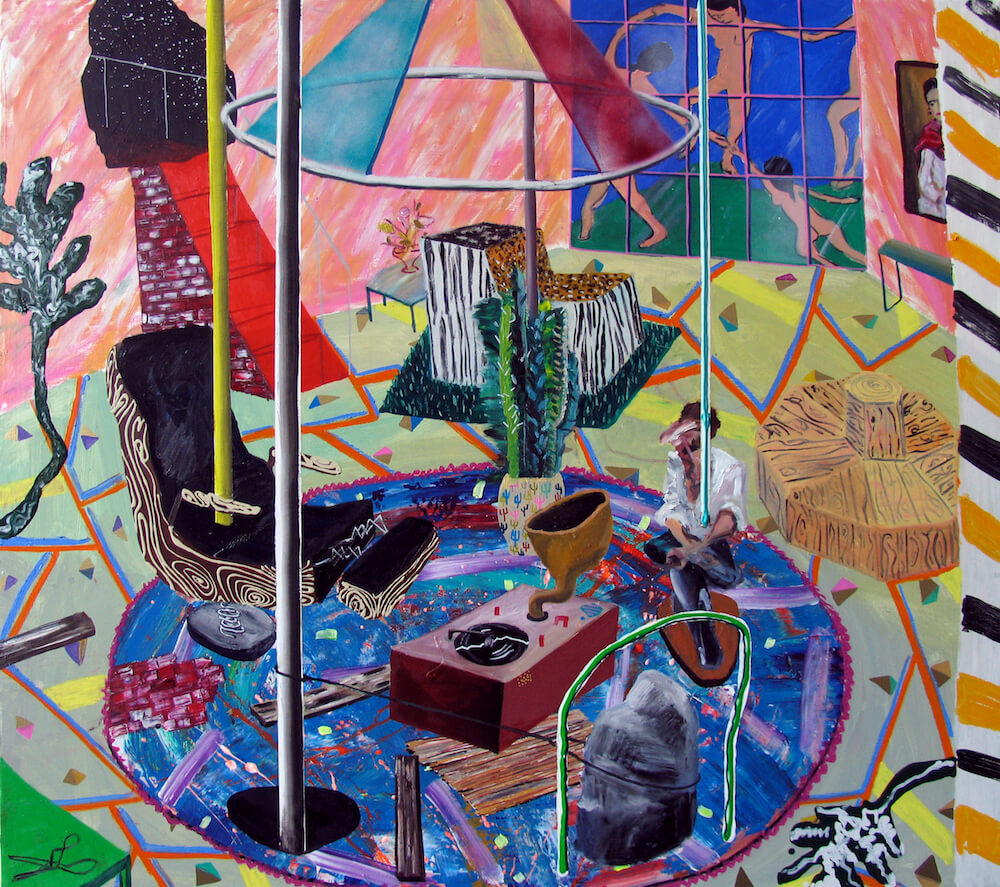
You also recently did a series of monoprints that were exhibited in a show Surprise Anxiety at Pace Prints. What was it like for you to do prints rather than paintings?
I had a hard time doing them, but I really loved that. It was the same kind of process where I didn’t know what it was going to turn out like. The idea of letting go of control was frustrating, especially when you’re the only one who can make it, but at the same time, that’s what I like about it. It was really challenging. It seems like if you’re a painter, it should be easy to make monoprints too, but it’s totally the opposite. You can’t get away with anything. Every mark you make has to be really clean or if you have any smudge, it’s going to transfer. I also make larger paintings so working small was hard for me. I would spend all day on this really small painting that looks great when it’s on the plate and then after running it through, I’d think, “That’s not what I made.” In a lot of ways, though, it was great because I wouldn’t have made those decisions in the studio. I got better at it as the time went on, but for the first few months, I wondered if I could do it at all.
With the title Surprise Anxiety, I thought not only of the anxiety of printmaking, but also just the general anxiety in contemporary society. Do you see a connection between current sociopolitical events and what comes out in your work?
Totally. I feel like we all feel out of control right now. There’s such a stretch between both sides that you feel powerless. There’s both this feeling of hope and anxiety. How do you let go, let it happen and be okay? I think the act of how I’m working is dealing with that. A lot of the paintings have something you’re looking through to another side. We’re in a place where we want to be somewhere else; we’re over here, but we want to be there. There’s a connection to change and hoping that the future will be different.
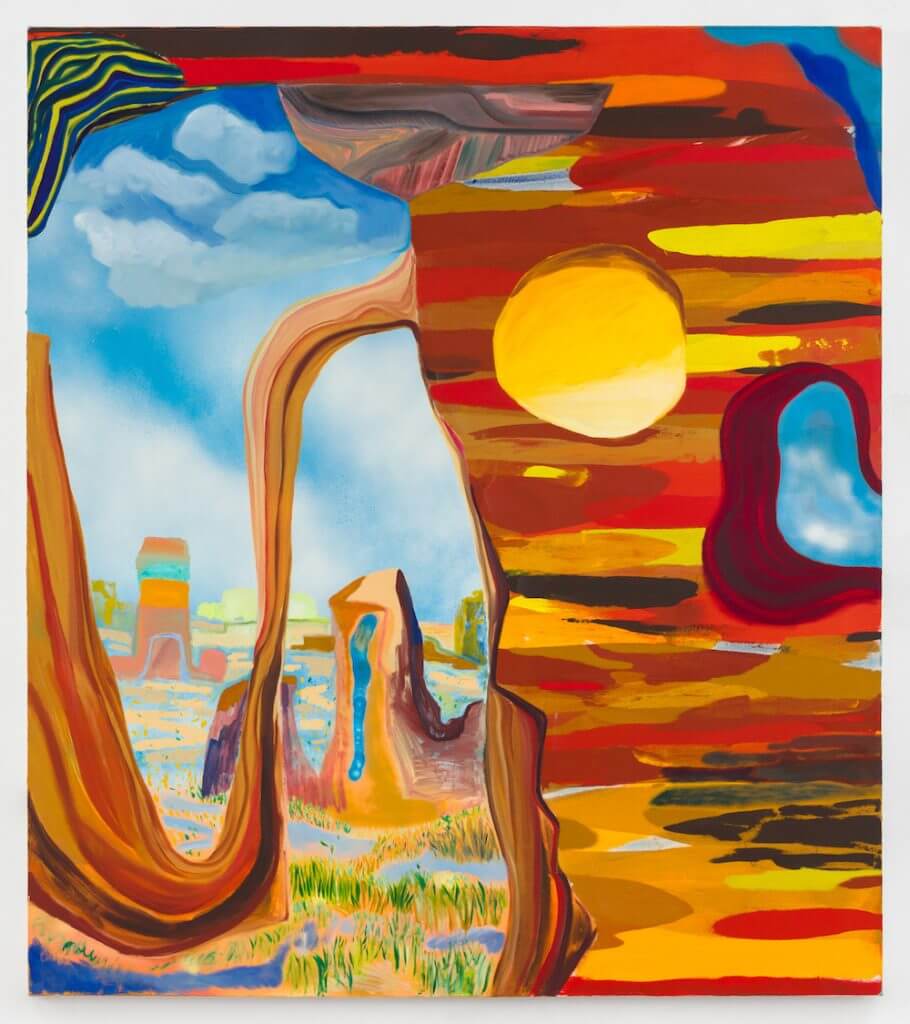
There is definitely also something to be said for making utopian landscapes in which viewers can get lost as an escape from tough times. How do you want the viewers to experience the work?
I want them to come to the work and feel this sense of something better or just something to enjoy. Sometimes, the colors bring you in, but if you were actually in that place, it would be really scary. They do show this dark side or anxiety that could also connect with people. I think there’s always something that draws you to the landscapes but then, unsettles. The interiors felt the same way. You wanted to go there to look at them, but once you’re there, it was kind of scary. I think there’s always been this push and pull between those two opposites that I enjoy.
Responses